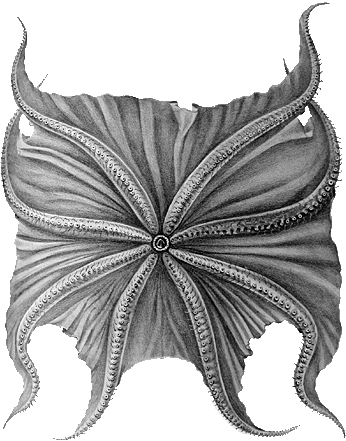Grimpoteuthis pacifica
Richard E. Young and Michael VecchioneIntroduction
Grimpoteuthis pacifica was described from a single, mutilated animal with only portions of the body remaining. As a result, only an incomplete description has been made and some species cannot be clearly separated from it. Descriptions of new specimens from the type locality are badly needed.
Characteristics
- Arms and web
- Arms each with 52 small suckers, largest opposite ventral attachment of web to arm.
- Proximal 6 suckers "stand together;" suckers further apart halfway along arms.
- Web attaches to arm dorsally nearly at tip; web attaches to arm ventrally at just over half the arm length.
- Single web nodules present. Shaped as nodule not elongate.
- Suckers with faint radial markings.
- Cirri begin between suckers 6 and 8.
 Click on an image to view larger version & data in a new window
Click on an image to view larger version & data in a new window
Figure. Ventral attachment of the web to an arm of G. pacifica showing a web nodule. Drawing from Hoyle, 1886.
- Eyes
- Large. Occupy all available space between fins and arms.
- Large. Occupy all available space between fins and arms.
- Gills
- "Spheroidal nodule with meridional grooves." (Presumably this is a half-orange shape.)
- "Spheroidal nodule with meridional grooves." (Presumably this is a half-orange shape.)
- Beaks
- Illustrated but not described.
- Shell
- Wing bears long, grooved outer surface. Only the wing was exposed and described.
- Wing bears long, grooved outer surface. Only the wing was exposed and described.
- Pigmentation
- "Deep purplish madder, paler outside the umbrella and on the fin."
- Measurements
- Fin width - 15 mm.
- Fin length - 55 mm.
- Largest sucker diameter - 2.5 mm.
- Longest cirrus length - 5 mm.
- Arm I length: Right, Left - 170 mm, 145 mm.
- Arm II length: Right, Left - 140 mm, 155 mm.
- Arm III length: Right, Left - 130 mm, 140 mm.
- Arm IV length: Right, Left - 150 mm, 135 mm.
Comments
The above description was taken from Hoyle (1886).
Among Pacific species, G. pacifica differs from:
- G. abyssicola in having fewer suckers (52 vs 77).
- G. bathynectes possibly by longer cirri (2x vs 1.1x in males, 1.3x in females) and the position of the first cirrus (between suckers 6-8 vs suckers 3-4).
- G. hippocrepium by no clear characters other than locality.
- G. innominata in having longer cirri (2x vs 1x).
- G. meangensis in having fewer suckers (52 vs 67-70).
- G. tuftsi in having fewer suckers (52 vs 63-75).
Distribution
The type locality is off south-eastern Papua, New Guinea, South Pacific at 13°50'S, 151°49'E. The type specimen was captured in a tow that fished to 4500 m.
References
Hoyle, W. E. 1886. Report on the Cephalopoda Collected by H.M.S. Challenger during the Years 1873-76. Report of the Voyage of the Challenger, Zoology, 16 (44): 1-346, 33 pls.
About This Page

University of Hawaii, Honolulu, HI, USA

National Museum of Natural History, Washington, D. C. , USA
Page copyright © 2016 and
 Page: Tree of Life
Grimpoteuthis pacifica .
Authored by
Richard E. Young and Michael Vecchione.
The TEXT of this page is licensed under the
Creative Commons Attribution-NonCommercial License - Version 3.0. Note that images and other media
featured on this page are each governed by their own license, and they may or may not be available
for reuse. Click on an image or a media link to access the media data window, which provides the
relevant licensing information. For the general terms and conditions of ToL material reuse and
redistribution, please see the Tree of Life Copyright
Policies.
Page: Tree of Life
Grimpoteuthis pacifica .
Authored by
Richard E. Young and Michael Vecchione.
The TEXT of this page is licensed under the
Creative Commons Attribution-NonCommercial License - Version 3.0. Note that images and other media
featured on this page are each governed by their own license, and they may or may not be available
for reuse. Click on an image or a media link to access the media data window, which provides the
relevant licensing information. For the general terms and conditions of ToL material reuse and
redistribution, please see the Tree of Life Copyright
Policies.
- First online 13 May 2003
Citing this page:
Young, Richard E. and Michael Vecchione. 2003. Grimpoteuthis pacifica . Version 13 May 2003 (under construction). http://tolweb.org/Grimpoteuthis_pacifica/20126/2003.05.13 in The Tree of Life Web Project, http://tolweb.org/










 Go to quick links
Go to quick search
Go to navigation for this section of the ToL site
Go to detailed links for the ToL site
Go to quick links
Go to quick search
Go to navigation for this section of the ToL site
Go to detailed links for the ToL site